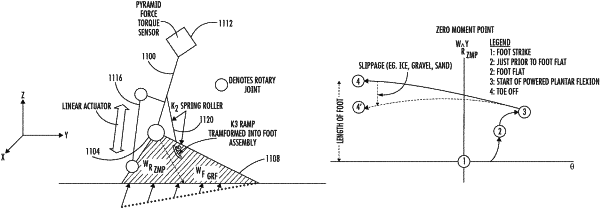| CPC A61F 2/70 (2013.01) [A61F 2/60 (2013.01); A61F 2/6607 (2013.01); A61F 2/72 (2013.01); A61H 1/0266 (2013.01); A61H 3/00 (2013.01); B25J 9/0006 (2013.01); G01L 5/0028 (2013.01); G01L 5/0061 (2013.01); G01P 21/00 (2013.01); H02K 7/06 (2013.01); A61F 2002/5003 (2013.01); A61F 2002/5007 (2013.01); A61F 2002/5018 (2013.01); A61F 2002/503 (2013.01); A61F 2002/5033 (2013.01); A61F 2002/5079 (2013.01); A61F 2002/5087 (2013.01); A61F 2002/6614 (2013.01); A61F 2002/6836 (2013.01); A61F 2002/701 (2013.01); A61F 2002/704 (2013.01); A61F 2002/7625 (2013.01); A61F 2002/763 (2013.01); A61F 2002/7635 (2013.01); A61F 2002/764 (2013.01); A61F 2002/7645 (2013.01); A61F 2002/7665 (2013.01); A61F 2005/0155 (2013.01); A61F 2005/0169 (2013.01); A61H 2003/001 (2013.01); H02K 7/116 (2013.01)] | 14 Claims |

|
1. A method for determining a change in traction between a foot member of an orthotic, prosthetic or exoskeleton apparatus and an underlying surface, the apparatus comprising a foot member, a lower leg member, an ankle joint for connecting the foot member to the lower leg member and a first actuator for applying torque to the ankle joint to rotate the foot member with respect to the lower leg member, the method comprising:
calculating ground reaction force and the zero moment pivot imparted by an underlying surface onto the foot member based on an inertial pose of the lower leg member, the torque applied to the lower leg member by the actuator, axial force applied to the lower leg member, and an angle between the foot member and lower leg member; and
calculating velocity of the foot member zero moment pivot based on the inertial pose of the lower leg member, the torque applied to the lower leg member by the actuator, the axial force applied to the lower leg member, and the angle between the foot member and lower leg member.
|